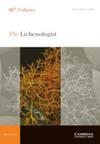对褐斑蛭科复合体的系统发育认识——狭窄地理地方性的证据和综合分类修订的迫切需要
IF 1.4
4区 生物学
Q4 MYCOLOGY
引用次数: 0
摘要
地衣形成真菌(LFF)的种类显示出一系列的地理分布模式。在广泛分布的地衣形成真菌物种中,种群间的生殖隔离程度和遗传亚结构差异很大,在某些情况下掩盖了未被认识的多样性或有意义的生物地理模式。褐斑蝗(Raymond ex Lam)。,直流)。Schaer。美国的纬度。(Lecideaceae)是一种广泛分布的物种复合体,自其最初描述以来已经研究了两个多世纪。L. atrobrunnea群体的多样性在北美西部是最高的,在那里,令人眼花缭乱的形态和化学成分可以在局部尺度上发生。在这里,我们调查了是否假定的世界性分布的L. atrobrunnea s.l at。是分类学限制的产物,掩盖了该物种复杂的生物地理模式。为了解决这些问题,我们从标准真菌条形码标记(ITS)中编译了该复合体内100多个标本的序列数据,以及来自这些样本子集的基因组规模数据,这些数据代表了超过1600个单拷贝核基因,跨越超过3mb的基因组。我们的研究证实了形态和化学上可变的Lecidea atrobrunnea类群反映了不同物种水平谱系的复杂性,从ITS区域推断出42-83种候选物种,并利用基因组尺度数据从样本子集推断出高水平的多样性。然而,基于表型和分子的物种边界仍然不稳定,最常见的名义分类群恢复为高度多系,不同分子物种划分方法之间存在冲突。我们的研究还强调了地理上受限制的物种的潜力,具有迷人的生物地理模式,在一定程度上挑战了假定的世界性分布。该研究为未来的研究提供了有价值的方向,这将对了解这一众所周知的物种复合体的多样性和建立健全的分类系统至关重要。本文章由计算机程序翻译,如有差异,请以英文原文为准。
Phylogenetic insight into the Lecidea atrobrunnea complex – evidence of narrow geographic endemics and the pressing need for integrative taxonomic revisions
Abstract Species of lichen-forming fungi (LFF) display an array of geographical distribution patterns. Among the broadly distributed lichen-forming fungal species, the degree of reproductive isolation and genetic substructure among populations varies widely, in some cases masking unrecognized diversity or meaningful biogeographical patterns. Lecidea atrobrunnea (Raymond ex Lam. & DC.) Schaer. s. lat. ( Lecideaceae ) is a widespread species complex that has been studied for over two centuries since its initial description. The diversity of the L. atrobrunnea group is highest in western North America, where a dizzying array of morphologies and chemistry can occur at local scales. Here we investigate whether the assumed cosmopolitan distribution of L. atrobrunnea s. lat. is an artifact of taxonomic limitations and masks biogeographical patterns in this species complex. To address these questions, we compiled sequence data from the standard fungal barcoding marker (ITS) for over 100 specimens within this complex, in addition to genome-scale data from a subset of these representing over 1600 single-copy nuclear genes spanning over 3 Mb of the genome. Our study corroborates the perspective that the morphologically and chemically variable Lecidea atrobrunnea group reflects a complex of distinct species-level lineages, with 42–83 candidate species inferred from the ITS region and high levels of diversity inferred from a subset of specimens using genome-scale data. However, both phenotype- and molecular-based species boundaries remained unsettled, with the most common nominal taxa recovered as highly polyphyletic and with conflict among different molecular species delimitation approaches. Our study also highlights the potential for geographically restricted species, with fascinating biogeographical patterns, challenging, in part, the assumed cosmopolitan distribution of L. atrobrunnea s. lat. This study provides valuable direction for future research that will be crucial in understanding diversification and establishing a robust taxonomy for this well-known species complex.
求助全文
通过发布文献求助,成功后即可免费获取论文全文。
去求助
来源期刊

Lichenologist
生物-真菌学
CiteScore
2.90
自引率
14.30%
发文量
23
审稿时长
6.0 months
期刊介绍:
The Lichenologist is the premier scientific journal devoted exclusively to the study of lichens worldwide. As the leading forum for the dissemination of new concepts and topical reviews, The Lichenologist reaches more scientists concerned with the study of lichens and lichen symbionts than any other single journal. All aspects of lichenology are considered including systematics and phylogenetics; molecular biology; ultrastructure, anatomy and morphology; secondary chemistry, effects of pollutants and use as bioindicators; biogeography. In addition to standard length research papers, the journal also publishes Short Communications and Book Reviews. A monthly issue may occasionally be devoted to papers deriving from a symposium.
 求助内容:
求助内容: 应助结果提醒方式:
应助结果提醒方式:


